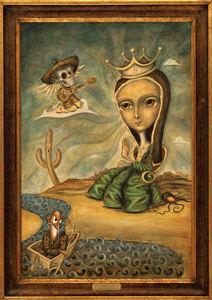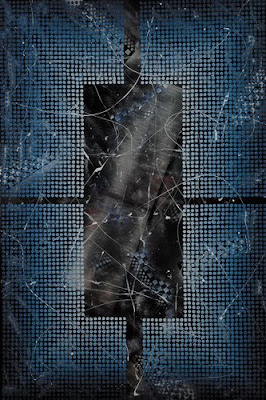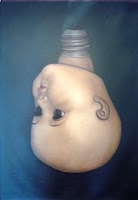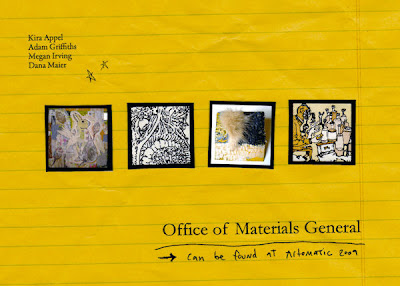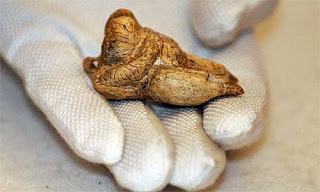Artomatic Opens Tomorrow!
 If you are an artist or art lover reading this post, then chances are that you already know what Artomatic (or AOM) is and all about this amazing spectacle.
If you are an artist or art lover reading this post, then chances are that you already know what Artomatic (or AOM) is and all about this amazing spectacle.
But just in case, a little review.
About once a year or so, under the guiding hand of a board of hardworking artists and volunteers, a large, unoccupied building in the Greater Washington, DC area is identified, and eventually filled with hundreds of artists’ works, loads of theatre and dance performances, panels, and everything associated with breathing a powerful breath of energy into the Greater DC art scene.
Let’s review: The idea behind AOM is simple: find a large, empty building somewhere in the city; work with the building owners, and then allow any artist who wants to show their work help with staging the show, pay a small fee and work a few hours assisting with the show itself.
Any artist.
Artists love AOM, but most DC area art critics hate it.
Why?
I think that in order to write a proper, ethical review of AOM, a writer must spend hours walking several floors of art, jam-packed into hundreds of rooms, bathrooms, closets and stairs. And I think that this is one of the main reasons that most art critics love to hate this show. It overwhelms them with visual offerings and forces them to develop a “glance and judge” attitude towards the artwork. It’s a lot easier to carpet bomb a huge show like this than to do a surgical strike to try to find the great art buried by the overwhelming majority that constitutes the great democratic pile of so so artwork and really bad artwork.
Add on top of that, an outdated, but “alive and kicking” elitist attitude towards an open show, where anyone and everyone who calls him or herself an artist can exhibit, sans the sanitizing and all-knowing eye of the latest trendy curator, and you have a perfect formula for elitist dismissing of this show, without really looking at it.
This harsh and elitist attitude towards art is not new or even modern. It was the same attitude that caused the emergence of the salons of the 19th century, where only artists that the academic intelligentsia deemed good enough were exhibited. As every art student who almost flunked art history knows, towards the latter half of that century, the artists who had been rejected from the salons (because they didn’t fit the formula of good art) organized their own Salon Des Refuses, sort of a 19th century Parisian Art-O-Matique.
And a lot, in fact, most of the work in the Salon Des Refuses was quite so so, but amongst the dreck were also pearls like Manet's Le Dejeuner sur 'Herbe (Luncheon in the Grass), Monet's Impression: Sunrise, (and we all know what art “ism” that title gave birth to) and an odd and memorable looking portrait of a young lady in white (The White Girl, Symphony in White, No. 1) by an American upstart by the name of James McNeill Whistler.
Everyone who was anyone in the art world hated and dismissed this anti-salon exhibition; except for the only one that really counts: Art History.
But how does a writer cover an arts extravaganza of the size of AOM once the eyes and mind become numb after the 200th artist, or the 400th or the 1,000th?
As an art critic, I once started a review of a past AOM by complaining how much my feet hurt after my 5th or 6th visit to the show, in a futile attempt to gather as much visual information as possible in order to write a fair review of the artwork. Over the years I have discovered that it is impossible to see everything and to be fair about anyone; the sheer size and evolving nature of the show itself makes sure of the impossibility of this task. But AOM is not just about the artwork.
As a gallerist, I also have visited AOM looking for new talent amongst the vast numbers of artists who come together under one roof. Over the years, together with my fellow DC area gallerists, we have plucked many artists from the ranks and files of AOM. Artists who since their first appearance at past AOMs have now joined the collections of museums and Biennials and have been picked up by galleries nationwide. Names like Tim Tate, the Dumbacher Brothers, Kelly Towles, Michael Janis, Kathryn Cornelius, Richard Chartier and that amazing worldwide phenomenon and best-selling author Frank Warren of PostSecret fame. But AOM is not just about the emerging superstar artist.
As an artist, one year I decided to participate in AOM, just to see what the guts of the machine looked like. "I know the monster well," wrote the poet Jose Marti, "for I have lived in its entrails."
My volunteer hours patrolling the halls on a Wednesday night at midnight, and still seeing people come in and out, and explore art on the wee hours of the morning, also left a footprint on the public impact of the exhibition. Dealing with prima donna artists, recharging my own artistic batteries from hundreds of fellow artists, many of them in their first public exposure, also left an impression. But AOM is not just about the public.
AOM is two things to me:
It is perhaps the nation’s most powerful incarnation of what it means to be a creative community of hundreds of working creative hands all aligned to not only create artwork, but also put together a spectacular extravaganza that re-charges the regional art scene as no museum or gallery show can. AOM is a community of artists employing the most liberal of approaches to art that there exists: the artists are in charge, and the artists make it work, and the artists charge the city with energy and zeal. And these descendants of those brave souls who challenged the academic salons of the 19th century face the same negative eye from the traditional art critics and curators of our museums, who challenge not just the art, but the concept of an open, non-juried, most democratic of art shows: a community of artists in charge of energizing the community at large. All good group shows must be curated! shout these chained critical voices.
And AOM is certainly the easiest and most comprehensive way to discover contemporary art at its battlefront lines, right at the birth of many artists, paradoxically showcasing the area's artworld's deepest and also its newest roots. This is where both the savvy collector, and the beginning collector, and the aspiring curator, and the sharp-eyed gallerist can come to one place with a sense of discovery in mind. And the ones that I missed in the past, and who were discovered by others, are ample evidence of the subjectivity of a 1,000+ group art show.
Viva AOM!
This year’s AOM runs from May 29 through July 5, 2009, and it is located at the new building at 55 M Street, S.E. - essentially on top the Navy Yard Metro - celebrating its tenth anniversary in a newly built 275,000 square foot "LEED Silver Class A building", whatever that means. It is all free and open to the public and all the details and dates and parties and performances and panels, as well as all the participating artists can be found at Artomatic.org.


